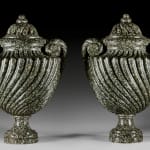Unknown
Further images
Provenance
Acquired from the Galerie Hughes Roux, Paris on 22nd July 1955 and thence by descent until very recent years.
Literature
Peter Hughes, “The Wallace Collection Catalogue of Furniture”, 1996, vol. III, pp.1382-84, nos. 285 (F358-9), illustrating and describing a very similar pair of porphyry covered vases in the Wallace Collection, London of the same date (measuring 44.2 cm. in height), each with a near identical body, lid and acorn-shaped finial but raised on a squatter foot (probably a later nineteenth century replacement) and with raised volute-shaped handles with transverse gadrooning. And pp. 1384-1386, nos. 286 (F364-5), illustrating and describing another pair of porphyry covered vases in the Wallace Collection with similar spiral fluting and gadrooning but of a slightly different overall design and with handles shaped as entwined serpents.
An extremely fine pair of Louis XVI serpentine covered vases, each with scrolled handles and an urn-shaped body carved with spiral fluting and gadrooning that twist in the opposite direction to one another, surmounted by a domed spiral fluted lid that twists in the opposite direction to those of the main body, with an acorn-shaped finial and supported on a turned circular foot.
These fine vases are typical of the fashion for urns, columns and objets de luxe made from serpentine, granite, porphyry and other hard stones that reached its apogee during the late eighteenth century. Apart from Marie-Antoinette and her husband Louis XVI, foremost among such collectors was the celebrated connoisseur Louis-Marie-Augustin, 5th duc d’Aumont premier valet de chambre du Roi (1709-82), whose vast deceased sale lasted nine consecutive days and included a number of objects made from hard stones. The first lot of the opening sale, 12th December 1782 consisted of a pair of vases that had very similar carved spiral gadrooning as seen here. The duc d’Aumont was so passionate about such works that he established ateliers specialising in the use of hard stones within the hôtel des Menus-Plaisirs on the rue du Faubourg-Poissonière. Under his patronage François-Joseph Belanger (d.1818) was engaged as architect-designer, the Genoese sculptor Augustin Bocciardi (fl. 1760-90) was employed to cut and polish the stones while where applicable the ciseleur-doreur Pierre Gouthière (1732-1813) was commissioned to supply gilt bronze mounts. Louis XVI shared the duc d’Aumont’s passion and in fact purchased a large proportion of his collection at his deceased sale as an endowment for the newly-born Musée du Louvre.
By that date the King had already established quarries in the Vosges Mountains that specialised in the cutting and working of serpentine and other hard stones. His Manufactures privilégiées du Roi then sold the goods through a Magasin ou dépôt des Ouvrages en roches, composées de granits, granitelles, jaspes, serpentins et porphyres in Paris. It is possible that the present vases came from that source.





